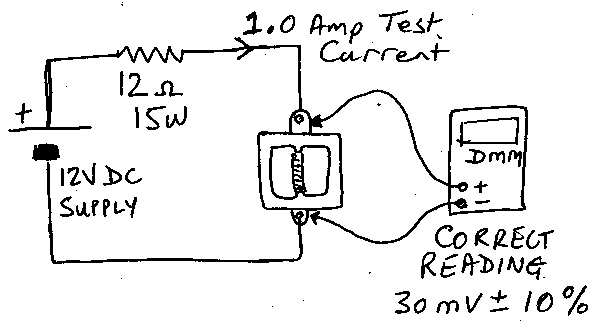Howard Dawson Audio
DIY-Testing Suspect Ribbon Inserts
There are only three ways to definitively prove that a ribbon insert is good - namely :
1) Direct sound output measurement - specialist equipment needed.
2) AC impedance measurement of tweeter as a complete unit - again this needs more specialist equipment than you are likely to have.
(The terminal DC resistance of the tweeter is a meaningless quantity, as this merely measures the matching tx. primary winding resistance.)
3) DC resistance measurement using a 4-wire technique and externally supplied test current. This method should be within the scope of most users.
Sometimes a ribbon insert can develop a high resistance due to imperfection in the soldered joints to the copper connecting tags, and while the element looks fine, a high resistance could explain loss of efficiency or even total loss of output.
Unfortunately it's not quite as simple as connecting an ohmmeter to the insert, as the value being measured is only 0.03 ohms (for all Kelly, Decca, and HRL-1) unless you have a long-scale bench DMM with 4-wire measurement capability - which is unlikely.
What's more, a typical pair of DMM test leads used in a normal 2-wire resistance measurement scenario themselves have a resistance of about 0.3 ohms, i.e. some 10 times more than what we are trying to measure!
The resolution can effectively be increased to enable a normal 3.5 digit DMM to be used by upping the measurement current to 1 Amp - provided by an external DC supply and series resistor, rather than the 1mA or so of the meter's internal resistance function.
The DMM (on its 200mVDC range) can then be applied across the insert under test, and the voltage reading obtained will indicate the insert's resistance.
The meter MUST be applied as shown, so as not to include any of the current-supply wiring resistance in the measurement.
Note that the insert MUST be carefully removed from the speaker magnet before doing this test, or a violent deflection will be produced that will destroy it.
Also take care that you do not accidentally connect the DC supply directly to the insert (i.e. without the intervening resistor).

home page
For further assistance or information :
Tel/Fax (01263) 734361
e-mail for further info
Please ensure you use a relevant subject line so that your message is not treated as spam, i.e. deleted unread.
If you send any attachments, e.g. photos, please try to keep total size below about 1Mb.
hand-crafted loudspeaker units for music lovers
